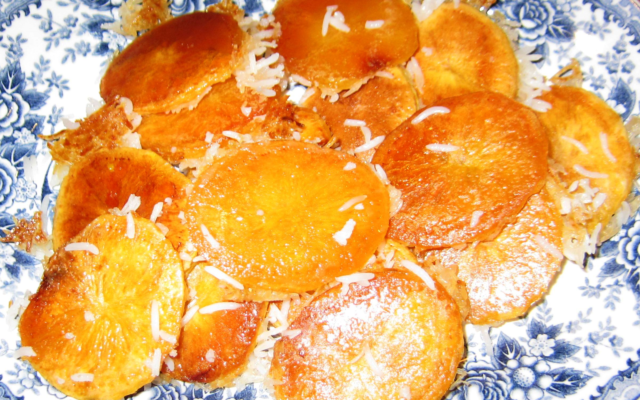Passover Recipes: Persian Jewish Flavors
Try out two excellent Iranian dishes for your Passover meals.
Iranian Jewish seders follow Sephardic custom with some distinct flavors. “We are allowed to have rice and beans, but not chickpeas or green peas,” said Farah Lalehzarzadeh, an immigrant from Iran who lives in Atlanta. She explained that her parents told her they cannot eat anything that gets bigger, similar to how bread leavens.
Among the most interesting aspects of Iranian and other Sephardic seders are the green onions laid out on the table. When it comes time to sing “Dayenu,” guests gently hit each other with the green onions to mimic whipping during slavery. “It’s so fun with the green onion! We wash it, we nicely put it on the table. We just try to have fun,” Lalehzarzadeh said.
Another custom is putting out walnuts on the seder table, she said. The night before, the whole walnuts are soaked in the shells, and the night of the seder, they are put on the table for those gathered to eat.
Lalehzarzadeh was excited to describe Persian charoset. Distinct from Ashkenazi charoset, which is commonly made from apples, nuts and spices, the charoset she makes largely consists of dates. “It is so yummy and very heavy,” she said. “We grind all the nuts – almonds, pistachios, cashews – and sesame. And then we put wine, and we put dates, and we put raisins. And a little water also.” It’s a joke between Iranians how delicious and strong the charoset is, she said. “It just tastes so good!”
The rest of the seder is essentially the same as Ashkenazi traditions, Lalehzarzadeh said. However, Iranian Jews are allowed to eat grains Ashkenazim can’t, such as rice. Lalehzarzadeh provided a popular Persian steamed rice dish with a stew to put on your seder table for Jews who are able to eat rice on Passover; otherwise, it is an excellent recipe to try out at a different time. The fried potatoes covered in saffron water are extremely tasty and sure to be a hit.
Persian Stew with Green Beans and Eggplant
1 package of beef or any kind of red meat (about
15 medium-sized pieces of meat)
1 onion
2 cups water, enough to fill over half the pot (it
will evaporate when cooking, and more can be
added)
1 can tomato paste
Green beans cut into small pieces
1 eggplant, cut into pieces
Salt, black pepper and turmeric, to taste
Cut the onion into pieces. Sauté the meat with the onion, salt, pepper, and turmeric until the onion turns translucent, then pour boiled water over it, filling a little over half the pot.
Add can of tomato paste. Cook at a simmer for a few hours, until the meat is cooked.
Add the green beans.
Peel and cut the eggplant and put into a strainer. Add salt and let stand for 10 minutes, until liquid drains from the eggplant.
If the stew is too watery, let it cook down until it thickens.
Fry the eggplant until cooked and then add to the stew.
Persian Rice, or Tahdig
3 cups basmati rice
1 potato
Salt
Water
Optional: dried dill, green peas, saffron
Fill a medium-sized pot with water and let it boil with a little salt. Wash and drain the rice and add it to the boiled saltwater.
Let the rice boil for 7 to 10 minutes, so it is slightly soft with a crunchy center.
Drain the rice in a strainer and rinse with cold water to halt the cooking process.
Heat oil in a pot over medium heat until it warms and add 1 cup of hot water.
Slice the peeled potato into thin coins and layer the slices at the bottom of the pot.
Add all of the rice. If desired, alternate layers of rice with green peas and dried dill.
Turn the temperature to low. Cover the pot with a paper tower and put the lid over it.
Cook for about one hour at a low temperature.
When finished, flip the pot onto a serving platter. There should be a crunchy crust of potatoes and rice. If desired, mix ground saffron with a little hot water and pour over rice.




comments